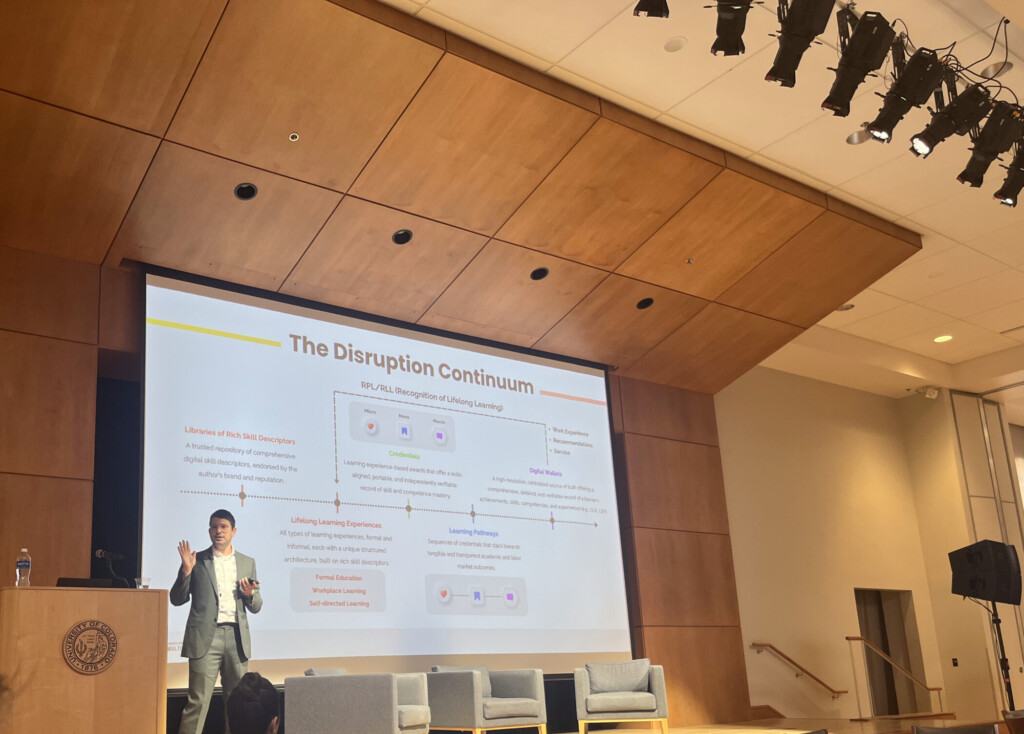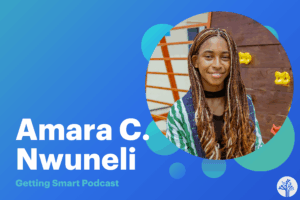What’s the Status of Badges? A Mid-Year Check-In at The Badge Summit
Key Points
-
Initiatives across the country are demonstrating early potential of what’s possible with a Learner Employment Record.

Back in February, I attended the Digital Credentials Summit from 1EdTech and wrote a recap of the experience, trying to document the many theories, players and learnings that I observed and met over the three days. A few weeks ago, I got the chance to see a bunch of familiar faces at The Badge Summit in Boulder (as well as many new ones!) Despite the overlap, it was hardly a repeat of February. We are now a bit further into some of the early pilots of LER ecosystem work. I’ll share some high-level reflections at the end of the piece, but you can see much of the context setting in my piece from earlier this year (linked above).
Here are a few of the initiatives that have matured since February and offer a glimmer of what’s possible in the world of skills-based hiring, credentialing, and the early stages of an LER ecosystem.
T3 Products and Tools
The T3 Network is a web of many initiatives, websites, tools, etc., in partnership with the U.S. Chamber of Commerce. A few of their products/initiatives are:
- JobSIDE
- LinkedCreds
- Resume Builder
- HR Open Standards
Let’s first start with the standardizing/defining part. JobSIDE is an initiative to collect rich and verified employer data regarding job postings, industry specifications, role descriptions, etc., to try to create a master library of these opportunities and disaggregate these postings into skills profiles, helping employers understand the most critical skills that make up each candidate profile. Ultimately, this tool creates an employer-validated record of job profiles that can be used to train LLMs and other sources. Additionally, it enables employers to map learning outcomes in a curriculum, credential, assessment, or learner record and to track which frameworks are being used by employers.
From there, let’s go to the learner/earner side. This begins with LinkedCreds, a tool designed with ease at its core. With LinkedCreds, any user can create a credential out of information. This could be an experience, a course, etc. Within this tool, the user is able to attach evidence, bolster the credential with supervisor recommendations and more. The best part is, it’s totally free and doesn’t even require an account. All it needs is a Google email association because it stores all of your credentials in your Google Drive.
LinkedCreds data then ports into the ResumeBuilder, a tool that meets the new Open HR Resume Standards and is capable of housing rich badge data, as well as more typical narrative and skills resume data.
T3 Initiatives
In addition to the above products and initiatives, T3 and Education Design Lab have been leading Experience You, an effort in multiple states to connect workforce boards, employers, and technology providers to help build out the LER ecosystem by translating past experience into skills-rich digital credentials using AI and associated technologies.
Many of these participants were present at the summit and gave updates on their tool and research.
Gobekli has developed TalentPass, a tool designed to make talent visible for everyone. Their platform emerged from the first round of Experience You and has been primarily tested and informed by workforce boards, including partnerships with Idaho Workforce Development Council and Carroll County Workforce Development and Carroll Community College. This tool has four core features: Pythia AI, profiles, Talent Tree, and Passport Pages.
iQ4 (Achievement Wallet) provides a skills-based end-to-end solution to discover, develop, and retain talent by addressing the skills gap. Their platform focuses on connecting learners, educational institutions, and employers. Their platform has been primarily tested and informed by various organizations, demonstrating strong outcomes in workforce optimization. This tool consists of six key components focused on digital journey, usability, wallet functionality, reporting, and enterprise solutions. It helps enable upskilling and reskilling, creates common resume formats, and supports interoperability through API integrations.
Western Governors University has developed the WGU Achievement Wallet, a platform for skills identification, occupational alignment, career exploration, and credential management. Their platform has been primarily tested and informed by current WGU students, employers through the Aspen Institute, and non-completer surveys. This tool consists of four functional sections: a profile section showing skills gaps, a credential section for managing credentials, a skills section with detailed information for resume writing, and a career pathways section for job alignment discovery.
Learning Economy Foundation is a nonprofit dedicated to creating systems that help learners control their data and create lifelong learning portfolios. For Experience You, they are focusing on a tool called Scout Pass, which has been primarily tested and informed by World Scouting, supporting 57 million scouts worldwide across 170 national organizations. Their current testing focuses on event-specific badges at Scout Jamborees, where they’ve supported both in-person and online exchanges, allowing for peer and self-issued credentials.
University of Phoenix focuses on recognizing prior learning assessments (PLA) and providing credentials for students’ demonstrated skills. Their project has been primarily tested and informed by analysis of existing PLA submissions to identify skill themes and cross-walking these skills with curriculum competencies. This tool aims to enhance the PLA process by creating awareness and improving the front-end process to encourage more students to use PLA, and by developing credentials that recognize skills demonstrated through the PLA process.
JobSpeaker helps individuals understand how to progress from where they are today to where they want to go in the workforce. They primarily work with educational institutions to provide career development support. Their platform has been primarily tested and informed by working with employers to understand valued skills, talent evaluation methods, effective skill presentation types, and employer groups willing to support such systems in the long term. This tool focuses on three main areas: exploration (understanding opportunities and pathways), learning (aligning learning with career goals), and work (connecting students with employers through skills-based hiring). It also centers on building an automatically generated “skills transcript” based on the courses and programs students complete.
Solutions for Information Design (SOLID) has developed SkillCertifyAI and digital badging solutions designed to make military and civilian competencies visible and actionable for workforce transitions. Their platform emerged from decades of competency analysis work and has been primarily tested and informed by Department of Defense services, civilian sector employers, and workforce development organizations through their expansion beyond government contracting. This tool focuses on evidence-based skills mapping, competency translation, and credential verification through blockchain-anchored micro-credentials. Their approach addresses the skills visibility challenge by translating military occupational specialties and civilian experiences into machine-readable competency frameworks that employers can understand and trust. Their platform has been primarily tested and informed by military personnel transitioning to civilian careers, educational institutions seeking credit for prior learning recognition, and employers needing reliable skills assessment mechanisms.
Skills FWD
SkillsFWD is an initiative to pilot and drive credentials in multiple regions. The following descriptions of the various efforts are found on their site. I was able to focus on a few specific efforts this week (all are worth reading more about) that are illustrative of what is possible:
Indiana: Scaling a Statewide LER Ecosystem in Indiana to Advance Skills-Based Hiring and Economic Mobility for All Hoosiers, led by Western Governors University, will help determine how to sustain and scale a comprehensive LER ecosystem that provides the human capital needed to drive a robust, forward-leaning economy through public-private partnerships.
In a session on Indiana’s work, I observed how the Achievement Wallet (from iQ4 and WGU) has transformed the resume into a collection of skills and credentials. At the same time, they are working on the employer-facing side with a tool called Skills Talent Pipeline (STP). In this tool, an employer can upload their job posting or other documents and get a skills breakdown that is then cross-referenced with all of the many profiles scanned by STP. This approach changes the dynamic of applying to a job to getting discovered for a job. If this changes, the most important part of a candidate’s application process will be knowing who they are and documenting it.
One of the most interesting elements of the WGU Achievement Wallet is that you can use your skills profile as a calibration tool to see where your skills gaps are for desirable career pathways.
Ohio: Central Ohio Talent Network, led by ASPYR, powers new modes of early career talent and employer matching at scale via LERs that leverage a work-based learning solution powered by SchooLinks. This tool enables students to identify their skills and find internship/job opportunities on the same platform, helping them determine where they might be a good fit. Through this effort, all juniors and seniors in the Central Ohio Columbus City Schools have a wallet.
Montana: Accelerate Montana’s Validated Skills, led by Accelerate Montana, is a pilot of statewide adoption of LERs among employers of all sizes in the construction trades and technology industries across urban, rural, and tribal communities. I attended a short talk on their work with the Blackfeet tribe. In this session, the designers shared that the skills language that they were using was not culturally relevant to the Blackfeet. This disconnect then led to more design sessions with the tribe to identify skills that are core to the cultural and place identity.
What does all of this mean?
My last recap post for the February summit ended with the following high-level takeaways (bold). Here’s how they hold up after this summit (italics):
After attending this summit, it has become clear that the technology is going to be LER ecosystem-ready faster than we are, but gathering varied stakeholders to chart a path forward will continue to be the next best step.
This is even more true to me now. The technology is there/nearly there, and adoption is the core speed bump and obstacle. The subject of a lifelong learning record is difficult for new users to grasp, and it can be challenging to see the value unless you are a hiring manager or a candidate who is tired of having to justify their experience in new and different ways. One of the attendees shared that the best way to introduce an LER to someone is to not say the words LER; rather, start with the pain points that it can address.
My build on this point is that we have to focus on the demand side of this space. We have a “skills-based” movement but it has limited reach on the user side and using these tools requires seeing how these tools serve you as the user. State-wide wallet initiatives are a great sign toward what’s possible in terms of reach and standardization, but given the shifting labor market, this may not be a silver bullet.
It’s impossible to attend every session at an event like this, but in most sessions, the assumption was that jobs would continue to grow over time. There was more visible fear about population decline than there was about available quality jobs. While both futures are possible, the role and utility of an LER has some variability dependent upon whether we have a job abundance or a job scarcity.
With AI growth, millions of available credentials, and a bevy of approaches to validation, it’s more important than ever to support learners in collecting and documenting rich evidence from their learning experiences, while also connecting them to mentors and industry leaders who can vouch for their applied skills.
This appears even more true after this event. There is consensus that evidence and context matter for skills AND for credentials, but very little guidance on “what evidence to capture” or how to build that into a recurring process/practice or authentic assessment. Unless we’re intentional with design and implementation, these solutions will only capture and validate credit-bearing experiences, which will likely re-create many of the same challenges that we have today with respect to access and opportunity.
K-12 needs to show up in this space. Very few secondary schools are investing in LER initiatives, yet these initiatives would increase access and value for every student.
This event had very limited K-12 representation, resulting in a similarly limited focus on K-12 issues and opportunities. I spent the last few days dabbling in some of these tools, and it has reaffirmed that we must start this work in K-12. Retroactively adding credentials, badges, experiences and translating that information to skills is laborious, while adding them incrementally is not only low effort and user-friendly, but it also helps shape how you learn in the moment. Competency-based education is an obvious and essential gateway into this work.
I would also add a takeaway to this list. We HAVE to start with the learner. While the employer’s needs are a critical piece of the puzzle, this emphasis can swing the scale too far, at risk of unintended negative consequences. An LER is a habit tool because learning is a daily and constant habit. Without focusing on the learner/earner, we risk recreating the same problems that we already face today.
Provocations aside, the event was a hopeful look at an efficient and articulate infrastructure for communication and recognition. The consistent refrain by the folks in the room was that the choir is growing—new people, sectors and organizations are finding their place and their urgency in the LER ecosystem. The exponential growth of tangible LER examples is a promising step into this future.







0 Comments
Leave a Comment
Your email address will not be published. All fields are required.